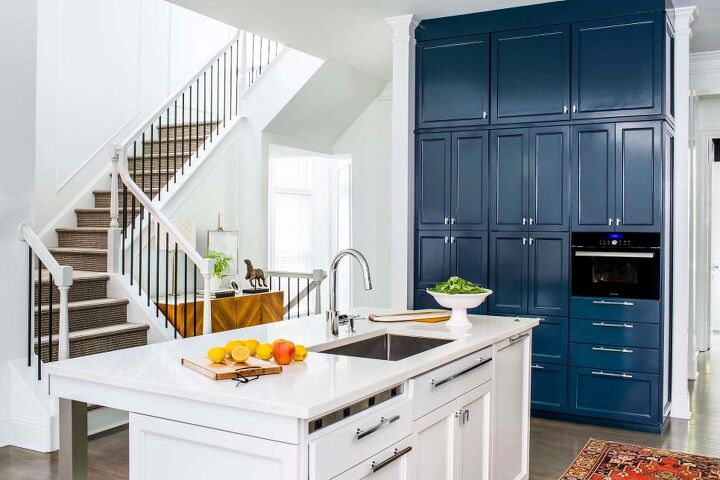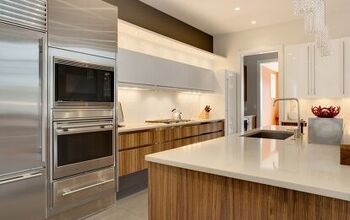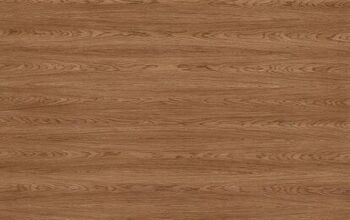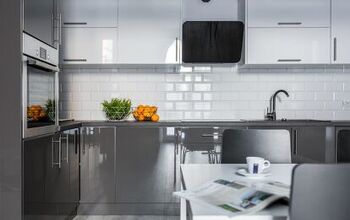What Are The Pros And Cons Of Acrylic Kitchen Cabinets?

Your kitchen cabinets play a major role in the overall ambiance of your home. If you’re looking to give your kitchen a fresh, new look, switching up the cabinetry is often a great place to start. With so many options to choose from, it’s very easy to fulfill both your budgetary and aesthetic needs.
Opting for acrylic kitchen cabinets is a great way to add instant style and functionality to your space. Their glossy sheen can help make your kitchen appear more vibrant, open, and visually appealing. Aside from aesthetics, acrylic cabinets are incredibly durable, easy to clean, and long-lasting. Of course, they do come with their own unique drawbacks including a high upfront cost and the fact that the glossy surface makes dirt, stains, and fingerprints more easily visible.
Over the years, high gloss cabinets – like acrylic – have gained popularity among homeowners for their elegant, sleek finish. Although they are often best suited for a modern, contemporary-style kitchen space, understanding their characteristics can help you identify how these types of cabinets will best complement your style and the rest of the décor in your home.
Do You Need to Hire Cabinet Installers?
Get free, zero-commitment quotes from pro contractors near you.

What is Acrylic?
Acrylic is essentially a non-toxic finish that delivers an impeccably smooth texture and a high-gloss look to the exterior of kitchen cabinetry. This synthetic material is high-quality, with an appearance that strongly resembles a mirror. Though, unlike glass, acrylic is shatter-resistant and does not crack or chip easily. As such, acrylic kitchen cabinets are often a popular alternative to glass.
The durability of acrylic kitchen cabinets comes from the fact that the material is a hard, synthetic, high-quality plastic. This finish comes in a wide variety of colors and sizes to achieve the desired look in your kitchen.
Types of Acrylic Cabinets
There are two main types of acrylic kitchen cabinets available on the market – acrylic faced doors and solid acrylic doors. The latter comes at a higher price point since they are constructed of acrylic all the way through, which means that the doors have a more vibrant, even, and colorful appearance.
Acrylic-faced doors, on the other hand, are a more affordable alternative. However, the process of applying the acrylic finish to the cabinet doors is very elaborate. It involves acrylic sheets being attached to an MDF board with adhesive. Then, the acrylic sheets are coated in a protective layer and sealed at all the edges.
Pros and Cons of Acrylic Kitchen Cabinets
Without a doubt, acrylic is a popular finish for kitchen cabinets that creates a unique, sophisticated look. The reflective material comes in a wide array of colors, making it easy to find one that fits the specific needs of your kitchen. However, just like any other types of kitchen cabinets, acrylic comes with its own individual pros and cons.
Pros of Acrylic Kitchen Cabinets
- Aesthetics: The major advantage to opting for acrylic kitchen cabinets is the appearance. For high-end modular kitchens, a premium high-gloss finish is often desired. Fortunately, acrylic is an excellent choice and the finish is both visually appealing and inviting. Not only does it create an elegant display in your kitchen, but the reflective surface can also give the illusion of spaciousness. With acrylic cabinets, you’ll never have to work about your kitchen looking dull.
- Variety: Acrylic finishes come in a wide array of wonderful colors, which makes this option ideal for those who want to maximize customization in their kitchen. You have tons of options when trying to find something that will complement your interiors.
- Durability: Acrylic is known for being incredibly durable and it will maintain its appearance for many years to come. The material is an excellent choice for items that see frequent, everyday use as it can stand up to wear and tear. Not to mention, acrylic is scratch-resistant, moisture-resistant, and UV light-resistant.
- Waterproof: Since these cabinets are moisture-resistant and waterproof, they do not require any sort of treatment or sealant in order to extend their life.
- Longevity: Because of the exceptional durability of the finish, both the gloss and shine of your acrylic kitchen cabinets will remain for a considerable number of years.
- Maintenance: Cleaning acrylic cabinets is as easy as giving them a quick wipe down with mild, soapy water.
Cons of Acrylic Kitchen Cabinets
- Visible dirt: The glossy surface of acrylic cabinets means that dirt, stains, and fingerprints show up more easily. As such, these types of kitchen cabinets do require more frequent cleaning.
- Cost: Since acrylic is considered a premium finish for cabinets, it comes at a premium cost. When compared to other types of finishes, acrylic is more expensive.
- Replacement difficulties: Should you need to replace one of your cabinet doors down the line, you may have some difficulties with matching up the shades. After years have passed, it may be challenging to find the exact hue of your cabinets to match them up perfectly. In which case, you may end up having to replace all of them in order to achieve a seamless look again.
- Installation: It has been reported that acrylic sheets sometimes have issues sticking to the MDF or ply base. To avoid this problem, it’s important that the installation and workmanship is done by an experienced professional.
Cost of Acrylic Kitchen Cabinets
Although acrylic is a premium finish, it is often less expensive than real wood cabinets. The price of acrylic kitchen cabinets is between $5,000 and $20,000, for materials and installation. Such a wide price range has to do with the fact that the cost varies depending on the base material that is used. In most cases, the finish comes in flat panels that are applied to the base material. This base material can be anything from solid wood to MDF to metal.
To put things into perspective, the following table outlines average prices for common kitchen cabinet materials:
| Cabinet Material | Average Cost |
| Wood Veneer | $4,000 to $9,000 |
| Laminate | $5,000 to $8000 |
| Acrylic | $5,000 to $20,000 |
| Solid Wood | $6,000 to $12,000 |
| Stainless Steel | $22,000 to $36,000 |
Other Types of High Gloss Cabinets
High gloss kitchen cabinet doors are often an impressive addition to modern kitchens. Not only do they help make the room feel more vibrant, but they are also excellent at opening up smaller spaces. If you want high gloss cabinets in your kitchen, acrylic isn’t the only finish that you have to choose from. Other options include:
Thermofoil
Often referred to as Rigid Thermal Foil, or RTF, Thermofoil is a type of cabinet door that has roughly the same appearance and feel as finished cabinet doors. However, they are constructed out of durable vinyl that has a long lifespan and is easy to clean. Thermofoil is commonly used in homes, condominiums, or apartments that need a quick update.
The major downside to this type of high gloss cabinet door is that the material cannot withstand too much heat or moisture. Over time, the layers will fall off which makes this choice not recommended for use in the kitchen.
Lacquer
Lacquered wooden cabinets are a very popular choice for DIYers looking to achieve that high-gloss look in their kitchen. The finish is easy to apply and very budget-friendly. Once dried, lacquer provides a smooth, mirror-like finish to your cabinets that closely resembles acrylic.
Acrylic vs. Laminate
Made out of thin layers of plastic resins and flat papers fused together, laminate is an artificial multi-layered material that is also a popular choice for kitchen cabinets. In fact, many homeowners have a hard time choosing between acrylic and laminate when designing a modular kitchen. Laminates come in a wide variety of colors and finishes as well, including wooden, matte, glossy, and high-gloss.
Like acrylic, laminates are durable and can withstand regular wear. However, they are not recommended for heavy usage. Although there are high-gloss laminate finishes available, they do not match up to the glass-like shine that you get with acrylic. Glossy laminate cabinets are comparatively less reflective and less striking overall.
In terms of cost, laminate cabinets are more affordable than acrylic. So, if you’re looking for a budget-friendly alternative to acrylic that has a slightly less glossy appearance, you may want to consider going with laminate.
How to Clean Acrylic Kitchen Cabinets
For best results, it’s recommended to clean your acrylic kitchen cabinets with mild soap and water using a soft micro-fiber cloth. Avoid using brushes, paper towels, scrapers, or scourers on the cabinets. You also never want to dry wipe acrylic finish and should not use household cleaners or abrasives.
Always look at the active ingredients in your cleaners before you use them to ensure that they don’t have any chemicals that could be harmful to the finish. Though not required, you can apply an acrylic polish to the surface on a weekly basis to help keep the finish in optimum condition.
Do You Need to Hire Cabinet Installers?
Get free, zero-commitment quotes from pro contractors near you.

Related Questions
Are gloss cabinets high maintenance?
Gloss kitchen cabinets do tend to be higher maintenance than their matte counterparts, solely because general wear and tear, scratches, and dirt show up more clearly.
How do you remove grease from acrylic cabinets?
Always tackle grease and spills immediately by wiping them with a microfiber cloth, mild soap, and water – don’t leave them to dry on the surface. They’ll be much harder to remove after they’ve dried and you could potentially damage the cabinets.

Jessica considers herself a home improvement and design enthusiast. She grew up surrounded by constant home improvement projects and owes most of what she knows to helping her dad renovate her childhood home. Being a Los Angeles resident, Jessica spends a lot of her time looking for her next DIY project and sharing her love for home design.
More by Jessica Stone


























![12 Washing Machine Brands to Avoid [with Recall Data]](https://cdn-fastly.upgradedhome.com/media/2023/07/31/9075781/12-washing-machine-brands-to-avoid-with-recall-data.jpg?size=350x220)


